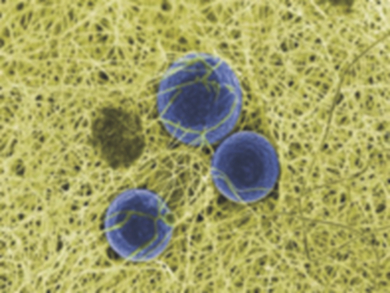The foreign body response (FBR) of biological tissue is a highly complex and dynamic process, which begins immediately after an injury. It results in various tissue responses, such as the recruitment of inflammatory cells, the fusion of macrophages (a type of white blood cell) to form so-called foreign body giant cells (FBGCs), and eventually in the encapsulation of the foreign body.
Themis R. Kyriakides, Yale University, New Haven, CT, USA, and colleagues have developed a multi-compartment drug delivery system that is able to deliver different drugs at different time scales which correspond to the dynamic process during FBR. This allows a modulation of the tissue response. The drug eluting constructs were fabricated by simultaneous electrospinning (creates core–shell fibers) and electrospraying (creates spheres).
The fibers with a core-shell structure allow the delivery of a hydrophilic drug (the antibiotic ampicillin) from the core and a hydrophobic drug (the anti-inflammatory drug Bay 11-7082) from the shell. These two-component fibers release their respective drug over different timescales. The fibers form a nonwoven fibrous mat with spheres containing a third drug (the antifibrotic agent pirfenidone).
The use of this hybrid system (pictured) for FBR was demonstrated in vivo. It successfully mitigated the macrophage fusion after one week and the fibrotic encapsulation after four weeks. Morevoer, the constructs are rapidlyand easily fabricated making them ideal candidates for use in systems where the ability to engineer a dynamic host process is desired.
- Multicompartment Drug Release System for Dynamic Modulation of Tissue Responses,
Aaron H. Morris, Rajwant S. Mahal, Jillian Udell, Michelle Wu, Themis R. Kyriakides,
Adv. Healthcare Mater. 2017.
DOI: 10.1002/adhm.201700370



